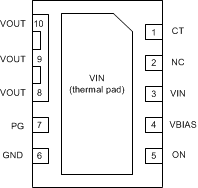SLVSDK1C May 2016 – September 2017 TPS22990
PRODUCTION DATA.
- 1 Features
- 2 Applications
- 3 Description
- 4 Revision History
- 5 Device Comparison Table
- 6 Pin Configuration and Functions
- 7 Specifications
- 8 Parameter Measurement Information
- 9 Detailed Description
- 10Application and Implementation
- 11Power Supply Recommendations
- 12Layout
- 13Device and Documentation Support
- 14Mechanical, Packaging, and Orderable Information
6 Pin Configuration and Functions
DML Package
10-Pin WSON
Top View

DML Package
10-Pin WSON
Bottom View

Pin Functions
| PIN | TYPE | DESCRIPTION | |
|---|---|---|---|
| NO. | NAME | ||
| 1 | CT | O | VOUT slew rate control |
| 2 | NC | — | Not internally connected |
| 3 | VIN | I | Switch input. Bypass this input with a ceramic capacitor to GND |
| 4 | VBIAS | P | Bias voltage. Power supply to the device |
| 5 | ON | I | Active high switch control input. Do not leave floating |
| 6 | GND | GND | Device ground |
| 7 | PG | O | Power good. Active high, open drain output. Tie to GND if not used |
| 8 | VOUT | O | Switch output |
| 9 | |||
| 10 | |||
| — | VIN (Thermal Pad) | I | Switch input. VIN and thermal pad (exposed center pad) to alleviate thermal stress. See the Layout section for layout guidelines |